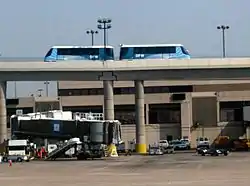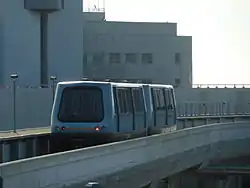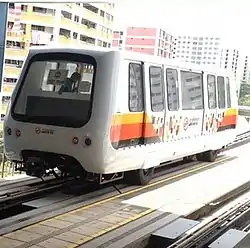Bombardier Innovia APM
Innovia APM (stylized as INNOVIA APM) is a rubber-tired automated people mover system (APM) manufactured by Bombardier Transportation. The APM technology was originally developed by Westinghouse, then owned by Adtranz, and most recently acquired by Bombardier in 2001.[1] Since its market debut in 1971, there have been three generations – Innovia APM 100 (known originally as C-100 and CX-100), Innovia APM 200 (originally known as just Innovia people mover) and the latest Innovia APM 300.

History
Development began in the 1960s when Westinghouse (bought by AEG in 1988, later Adtranz in 1996) first engineered the South Park APM demonstration project in Pittsburgh, Pennsylvania in 1963. The technology came to be known as the Skybus,[2] because it was a rubber-tired vehicle, similar to a bus that operated on a designated elevated roadway. From the very beginning, it was designed to be an automated rapid transit system. Engineers believed that it would be able to move 5,000 to 14,000 per hour per direction, and could offer around-the-clock service every two minutes. The first attempts to bring the Skybus technology to market were controversial,[3] with political leaders holding opposing views on the prospects of a rubber-tired mass transit system. Eventually plans to implement a Skybus system in Pennsylvania were rejected.[4] Despite this, work continued on the technology.

In 1971, the first airport people mover system was opened at Tampa International Airport – beginning a new chapter in transportation history.[5] After Westinghouse was acquired by Adtranz, the technology was marketed as the Adtranz C-100 automated people mover system. The C-100 system (and the newer CX-100 system) was relatively successful in the 1980s and 1990s with 14 new systems delivered. As the competing Mitsubishi Crystal Mover technology grew in popularity, Adtranz began developing a new, more aerodynamic model known as Innovia, which started testing in 1999. In addition to its sleeker appearance, the new Innovia people mover also offered greater speeds, tighter turns, full composite construction and a choice in end caps. The first Innovia people mover system delivered opened in 2005 at Dallas/Fort Worth International Airport.[6] Despite the development of this newer model, Bombardier continued to sell the CX-100 technology under then name Innovia APM 100[7] while it also marketed the new Innovia people mover technology (last Innovia APM 100 system delivered in 2010[8]). However, after the development of a third generation model and a rebranding strategy by Bombardier to label its entire automated transit system portfolio as ‘INNOVIA’, the two previous models became legacy systems and are no longer marketed to new customers. Although, existing customers can and do still order more vehicles as needed. The third and latest model is called the Innovia APM 300 system. It looks very similar to the original Innovia people mover (now called the Innovia APM 200 system), but is longer, more energy efficient and capable of 6-car train configurations.[9]
In November 2014, Bombardier signed a joint venture (JV) agreement with CSR Puzhen in China to develop and manufacture Innovia APM vehicles (as well as Innovia Monorail vehicles) for the Chinese market.[10]
Production
Innovia APM vehicles are assembled in West Mifflin, part of the Greater Pittsburgh Area, Pennsylvania. The multi-building facility specializes in automated people mover technology and has three test tracks.[11] Vehicles manufactured by the joint venture, CRRC Puzhen Bombardier Transportation Systems Limited, are manufactured in Wuhu, Anhui Province in China.[12]
Implementations



Innovia APM 100 systems
At airports:
- AeroTrain at Kuala Lumpur International Airport, Malaysia [14]
- AirTrain at San Francisco International Airport, United States [15]
- Automated Guideway Transit System at Denver International Airport, United States[16]
- Beijing Capital International Airport, China [17]
- Changi Airport in Singapore (replaced in 2006 by a Mitsubishi Crystal Mover)
- Madrid Barajas International Airport, Spain
- McCarran International Airport People Movers (three lines in total) at McCarran International Airport, Las Vegas, Nevada, United States
- Orlando International Airport, United States (Gates 70-129 Only.)
- Pittsburgh International Airport People Movers at Pittsburgh International Airport, United States
- Satellite Transit System, Seattle-Tacoma International Airport, United States
- SkyBridge at Leonardo da Vinci Airport, Italy
- SkyLine at Frankfurt Airport, Germany
- SMF Automated People Mover at Sacramento International Airport, United States
- Tampa International Airport Airside, United States
- TerminaLink at George Bush Intercontinental Airport, Houston, Texas, United States
- The Plane Train at Hartsfield-Jackson Atlanta International Airport, United States
- Tracked Shuttle System at London Gatwick Airport, United Kingdom
- Track Transit System at London Stansted Airport, United Kingdom
Urban systems:
- Metromover, Miami, Florida, USA[18]
- Bukit Panjang LRT, Singapore[19]
- Zhujiang New Town Automated People Mover System, Guangzhou, China[8]
Innovia APM 200 systems
- Skylink at Dallas-Fort Worth International Airport, USA[20]
- London Heathrow Airport, Terminal 5, United Kingdom [21]
- PHX Sky Train, Phoenix Sky Harbor International Airport, USA[22]
Innovia APM 256 systems
The Innovia APM 256 was designed as a direct replacement for the VAL 256 system
- Wenhu Line Taipei Metro, Taiwan[23]
- Airport Transit System at Chicago O'Hare International Airport, Chicago, Illinois, USA (reopens 2020)
At airports:
- Dubai International Airport Terminal 1 Concourse D, United Arab Emirates[24] (Terminal 3 uses Mitsubishi Crystal Mover instead)
- King Abdulaziz International Airport, Jeddah, Saudi Arabia[25]
- Munich Airport, Germany[26]
- LAX Automated People Mover, Los Angeles, California, United States[27]
Urban systems:
- Shanghai Metro Pujiang Line, China.
- Bangkok Mass Transit BTS Gold Line, Thailand
- Singapore LRT Bukit Panjang LRT Line, Singapore (new rolling stock ~2021, the C801B variant draws AC power used in APM 100 systems instead of DC)
Integrated Systems
Innovia APM vehicles operate as part of a fully integrated transit system[28] with all elements (vehicles, signaling, communications, power supply and distribution, trackwork, platform screen doors, etc.[29]) designed to function together as a complete package. Typically, these integrated systems are delivered as a turnkey transit system contract.[30]
Route layout and system configuration
Innovia APM systems are most often used in airport settings as inter-terminal connections or links to local amenities in and around the airport such as car rentals, parking garages and local public transit. Currently there are three urban systems used as feeder systems as part of a larger mass transit network. Innovia APM systems operate in tunnels, on elevated guideways, and sometimes in an open cut (pit) or a combination of tunnels and elevated guideways.
They can assume three different system configurations – shuttle,[31] loop,[32] and pinched loop.[33] The shuttle system is the least complex. One train operates on each lane of a dual lane guideway. After the train dwells in one of the end stations for passengers for entry and exit, it reverses direction and returns to the opposite end station. Because Innovia APM vehicles are fully automated, they do not require a driver's cab, which allows them to be bidirectional. A loop is an enclosed system that connects multiple stations along a track or guideway that is a continuous circle or closed curve. Loop systems can be designed as either a single lane or a dual lane configuration. A pinched-loop system shares common characteristics with both the shuttle and the loop systems. Pinched loops look like a dual-lane shuttle (with two parallel guideways), but trains can go from one track to the other changing direction via switches at each end. As a result, traffic on a pinched loop flows in opposite directions on two parallel tracks, but can accommodate many stations.[34]
Versions
- Bombardier Innovia APM 100 - the first generation model, formerly known as ADtranz CX-100
- Bombardier Innovia APM 100 C801 for Bukit Panjang LRT since 1999
- Bombardier Innovia APM 100 C801A for Bukit Panjang LRT since 2014
- Bombardier Innovia APM 200 - the second generation model
- Bombardier Innovia APM 256
- Bombardier Innovia APM 300 - the third generation model
- Bombardier Innovia APM 300 C801B for Bukit Panjang LRT from 2021
See also
Competing systems:
References
- "Bombardier gets Adtranz for a "bargain".(Brief Article)". highbeam.com. Archived from the original on 2015-03-29.
- "The Milwaukee Journal - Google News Archive Search". google.com.
- "The Pittsburgh Press - Google News Archive Search". google.com.
- "The Pittsburgh Press - Google News Archive Search". google.com.
- Leder, William H.; Sproule, William J. (2013). "Airport APMs—History and Future". Automated People Movers and Transit Systems 2013. pp. 14–37. doi:10.1061/9780784412862.002. ISBN 9780784412862.
- "Dallas/Fort Worth International Airport Skylink | Lea+Elliott". Leaelliott.com. Retrieved 2015-03-06.
- "Bombardier and London Gatwick Airport Celebrate the Completion of the New INNOVIA APM 100 System". Eurotransport Magazine. Retrieved 2015-03-06.
- DVV Media Group GmbH. "Guangzhou peoplemover enters service". Railway Gazette. Retrieved 2015-03-06.
- "Bombardier INNOVIA APM 300". Railway Technology. 2011-06-15. Retrieved 2015-03-06.
- "Thunder Bay News; NetNewsLedger.com - Bombardier Announces Joint Venture for China". Thunder Bay News; NetNewsLedger.com.
- "Pa. technology fund links universities, industry to solve innovation problems". TribLIVE.com.
- "CRRC-Bombardier JV Sign Contract for 19 APMs for Singapore". Railway-News. 2019-05-22. Retrieved 2020-06-18.
- "Topic : Automated People Mover". Metro Magazine. Retrieved 2015-03-06.
- http://www.aviation.ca/200811256491/news/canada/airports/6491-bombardier-consortium-awarded-contract-for-people-mover-at-malaysia-airport
- "Bombardier Signs New People Mover Contract at San Francisco Airport". Railway Technology. Archived from the original on 2015-04-02. Retrieved 2015-03-06.
- "Bombardier, Denver sign APM contract - Rail". Metro Magazine. 2010-12-22. Retrieved 2015-03-06.
- "Bombardier Completes Automated People Mover System in Beijing, China". Marketwired.com. Retrieved 2015-03-06.
- "People-Movers find their niche [Archive] - Dallas Fort Worth Urban Forum". Forum.dallasmetropolis.com. Archived from the original on 2015-04-02. Retrieved 2015-03-06.
- "Bombardier people mover cars enter service in Singapore". Global Rail News. 2014-11-19. Archived from the original on 2015-03-09. Retrieved 2015-03-06.
- HighBeam
- "metrotram.it". metrotram.it. 2011-01-29. Retrieved 2015-03-06.
- "PHX Sky Train, Sky Harbor International Airport, Phoenix". Railway Technology. 2011-06-15. Retrieved 2015-03-06.
- DVV Media Group GmbH. "Taipei Neihu Line inaugurated". Railway Gazette. Retrieved 2015-03-06.
- "Bombardier to build automated people mover system at Dubai Airport". Railway Technology. Retrieved 2015-03-06.
- Stephen White. "Bombardier wins Jeddah airport people mover deal". ConstructionWeekOnline.com. Retrieved 2015-03-06.
- "New automated people mover system for Munich Airport". Passengerterminaltoday.com. 2011-11-23. Retrieved 2015-03-06.
- Tom Wadlow (2018-06-11). "Los Angeles International Airport awards contracts for $4.9bn monorail installation". Construction Global. Retrieved 2018-06-13.
- http://trid.trb.org/view/1331637
- http://www.eurotransportmagazine.com/5777/news/industry-news/bombardier-to-design-build-supply-operate-and-maintain-an-innovia-automated-people-mover-system-for-munich-airport-in-germany/
- http://www.globeinvestor.com/servlet/WireFeedRedirect?cf=GlobeInvestor/config&vg=BigAdVariableGenerator&date=20120516&archive=ccnm&slug=201205160791049001
- https://ca.finance.yahoo.com/news/Bombardier-Celebrates-Opening-iw-707388192.html
- "Archived copy" (PDF). Archived from the original (PDF) on 2015-07-03. Retrieved 2015-03-02.CS1 maint: archived copy as title (link)
- http://cedb.asce.org/cgi/WWWdisplay.cgi?283768
- http://ntl.bts.gov/DOCS/11877/Chapter_24.htm